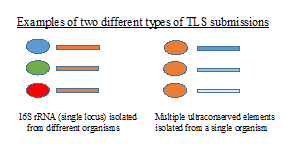~# Targeted Locus Study (TLS)
A Targeted Locus Study (TLS) is a large scale targeted sequencing project (>2,500 sequences) for either a single gene locus from multiple organisms or multiple conserved elements derived from a single organism.
All sequences included within a single TLS submission are linked within a single BioProject and include BioSamples for each isolation source included in the submission. All elements of a TLS study are grouped together and listed within the Sequence Set Browser.
TLS studies can accommodate large submissions of 16S ribosomal RNA isolated from an environmental source or a single gene compared across a population. These can be derived from uncultured or cultured organisms. These studies can also be composed of conserved elements, such as ultraconserved elements (UCEs) isolated from a single species.

What does a TLS project look like?
Like other International Nucleotide Sequence Database Collaboration (INSDC) large-scale projects, TLS projects consist of a master record with the following characteristics:
- The label 'TLS:' at the beginning of each Definition Line.
- DBLINK
- BioProject
- BioSample
- Keywords: TLS; Targeted Locus Study
Each TLS project is assigned a stable 4-letter TLS accession prefix, which does not change as the project is updated. In addition to the TLS accession prefix, the sequence identifiers have a version number corresponding to a particular TLS project update. Finally, each individual sequence within the project is assigned a unique accession number prefixed by the TLS accession prefix and version number. For instance, if a TLS project's assigned accession number is XXXX00000000, then that project's first version would be XXXX01000000, and the first sequence of that version would be XXXX01000001 (the last six digits of this ID identify each individual sequence).
An example of a TLS master record is KBUV00000000.
TLS sequence records are shared by all three INSDC databases and can be found using typical search methods in Entrez Nucleotide and Entrez Protein.
Submission Requirements
- Submit binned sequences from either a single locus (eg., 16S rRNA) from different organisms/environmental samples OR a set of conserved loci from a single organism (eg., UCEs isolated from a single bird).
- For environmental sample sequence surveys, each sequence should represent the individual phylotype, OTU or "bin" present in the sample.
- A TLS submission should include all of the sequences isolated for a single large scale study or BioProject. Multiple BioSamples can be included within a single project.
- Each sequence must be assembled from more than one overlapping sequence read derived from data experimentally determined by the submitter.
- Sequences should be screened for vector contamination and any vector/linker sequence removed. This includes the removal of sequencing primers.
- Sequences should be greater than 150 bp in length.
- Submission of sequence reads to SRA is highly recommended. If the reads are not to be submitted, provide study and environmental metadata to BioProject and BioSample.
Not Acceptable for TLS
- Assemblies from reads downloaded from a public repository.
- Sequences that have not been assembled.
- Projects that consist of less than 2,500 total sequences.
How to Submit to TLS
Submit ribosomal RNA TLS projects through the NCBI Submission Portal. All other sequence types should be submitted to GenBank using the submission tool table2asn. Submission details can be found in the TLS Submission Guide.
How to Update an Existing TLS Submission
Please contact gb-admin@ncbi.nlm.nih.gov with the reason for updating your sequences and instructions on how to update will be provided.
How to Search for TLS Projects
- You can search Entrez Nucleotide using the following term:
TLS master [prop].- For example:
TLS master [prop] AND 16S ribosomal RNA [Title]
- For example:
- The public submissions are available through the Sequence Set browser.
- The sequences can be downloaded from the NCBI FTP GenBank site.
